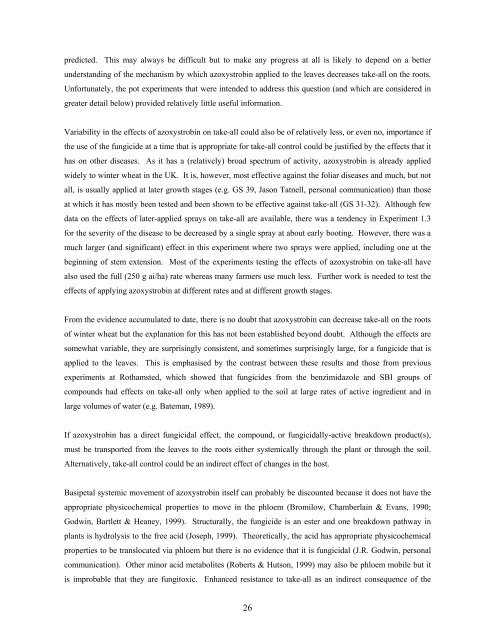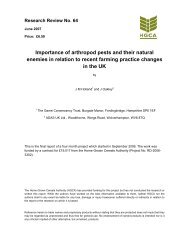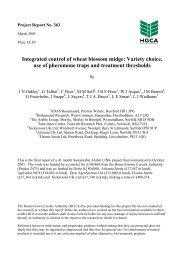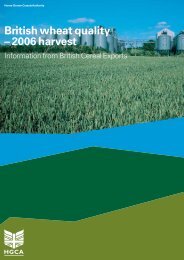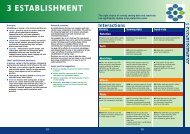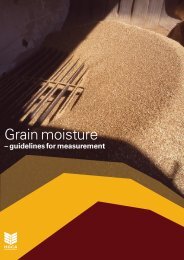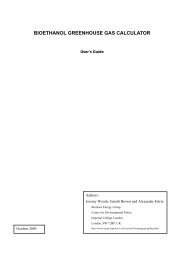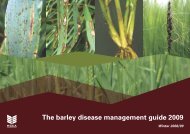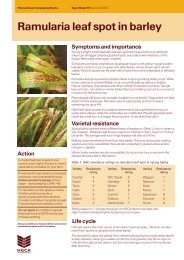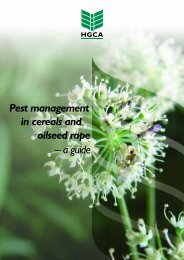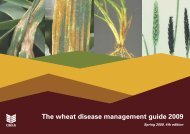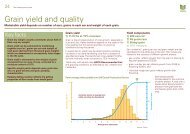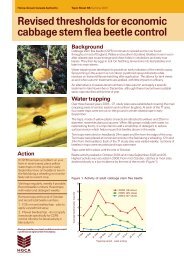PROJECT REPORT No. 285 EFFECTS OF ... - HGCA
PROJECT REPORT No. 285 EFFECTS OF ... - HGCA
PROJECT REPORT No. 285 EFFECTS OF ... - HGCA
- No tags were found...
You also want an ePaper? Increase the reach of your titles
YUMPU automatically turns print PDFs into web optimized ePapers that Google loves.
predicted. This may always be difficult but to make any progress at all is likely to depend on a betterunderstanding of the mechanism by which azoxystrobin applied to the leaves decreases take-all on the roots.Unfortunately, the pot experiments that were intended to address this question (and which are considered ingreater detail below) provided relatively little useful information.Variability in the effects of azoxystrobin on take-all could also be of relatively less, or even no, importance ifthe use of the fungicide at a time that is appropriate for take-all control could be justified by the effects that ithas on other diseases. As it has a (relatively) broad spectrum of activity, azoxystrobin is already appliedwidely to winter wheat in the UK. It is, however, most effective against the foliar diseases and much, but notall, is usually applied at later growth stages (e.g. GS 39, Jason Tatnell, personal communication) than thoseat which it has mostly been tested and been shown to be effective against take-all (GS 31-32). Although fewdata on the effects of later-applied sprays on take-all are available, there was a tendency in Experiment 1.3for the severity of the disease to be decreased by a single spray at about early booting. However, there was amuch larger (and significant) effect in this experiment where two sprays were applied, including one at thebeginning of stem extension. Most of the experiments testing the effects of azoxystrobin on take-all havealso used the full (250 g ai/ha) rate whereas many farmers use much less. Further work is needed to test theeffects of applying azoxystrobin at different rates and at different growth stages.From the evidence accumulated to date, there is no doubt that azoxystrobin can decrease take-all on the rootsof winter wheat but the explanation for this has not been established beyond doubt. Although the effects aresomewhat variable, they are surprisingly consistent, and sometimes surprisingly large, for a fungicide that isapplied to the leaves. This is emphasised by the contrast between these results and those from previousexperiments at Rothamsted, which showed that fungicides from the benzimidazole and SBI groups ofcompounds had effects on take-all only when applied to the soil at large rates of active ingredient and inlarge volumes of water (e.g. Bateman, 1989).If azoxystrobin has a direct fungicidal effect, the compound, or fungicidally-active breakdown product(s),must be transported from the leaves to the roots either systemically through the plant or through the soil.Alternatively, take-all control could be an indirect effect of changes in the host.Basipetal systemic movement of azoxystrobin itself can probably be discounted because it does not have theappropriate physicochemical properties to move in the phloem (Bromilow, Chamberlain & Evans, 1990;Godwin, Bartlett & Heaney, 1999). Structurally, the fungicide is an ester and one breakdown pathway inplants is hydrolysis to the free acid (Joseph, 1999). Theoretically, the acid has appropriate physicochemicalproperties to be translocated via phloem but there is no evidence that it is fungicidal (J.R. Godwin, personalcommunication). Other minor acid metabolites (Roberts & Hutson, 1999) may also be phloem mobile but itis improbable that they are fungitoxic. Enhanced resistance to take-all as an indirect consequence of the26


